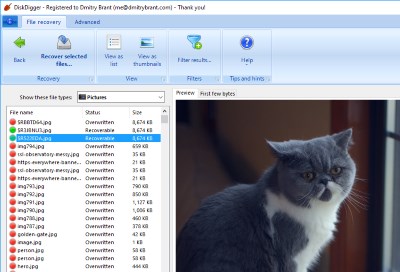News for February 2017
Tue, 01/31/2017 - 00:16 — Dmitry Brant
 Time for another update to both the Windows and Android versions of DiskDigger! Here's what's new in the latest version of DiskDigger for Windows:
Time for another update to both the Windows and Android versions of DiskDigger! Here's what's new in the latest version of DiskDigger for Windows:
- Improved detection of partitions on corrupted drives. Even if the partition table on your disk is corrupted or overwritten, DiskDigger will attempt to search for recoverable partitions independently of the partition table, and let you recover files from these lost partitions.
- When recovering files in "Dig Deep" mode, you can now filter recoverable files by general file types, such as "Pictures", "Documents", "Presentations", etc. This will automatically show you only files of the selected type, and make it easier to find the file(s) you're looking for. As before, you may also still apply a custom filter on the recoverable files, where you can search the files by name, size, and folder location.
- In "Dig Deep" mode, improved detection of whether or not a file is recoverable. DiskDigger provides hints of whether a file is recoverable by showing a red or green dot icon next to the file. This functionality has been expanded and improved in this update, to give you more confidence of the recoverability of each file.
- Fixed possible issues when recovering files larger than 2 GB. On certain filesystems, recovering a very large file may have resulted in an empty file. This has been fixed.
And here are the updates for the latest version of DiskDigger for Android:
- Improved compatibility with older versions of Android (all the way down to Android 2.3, Gingerbread).
- Improved messages and warnings when recovering large quantities of files.
- Support for recovering SQLite databases. This is usually the format used for storing SMS messages and contact information. Recovering deleted messages and contacts from these databases is not yet part of DiskDigger, but is planned for a future version.
